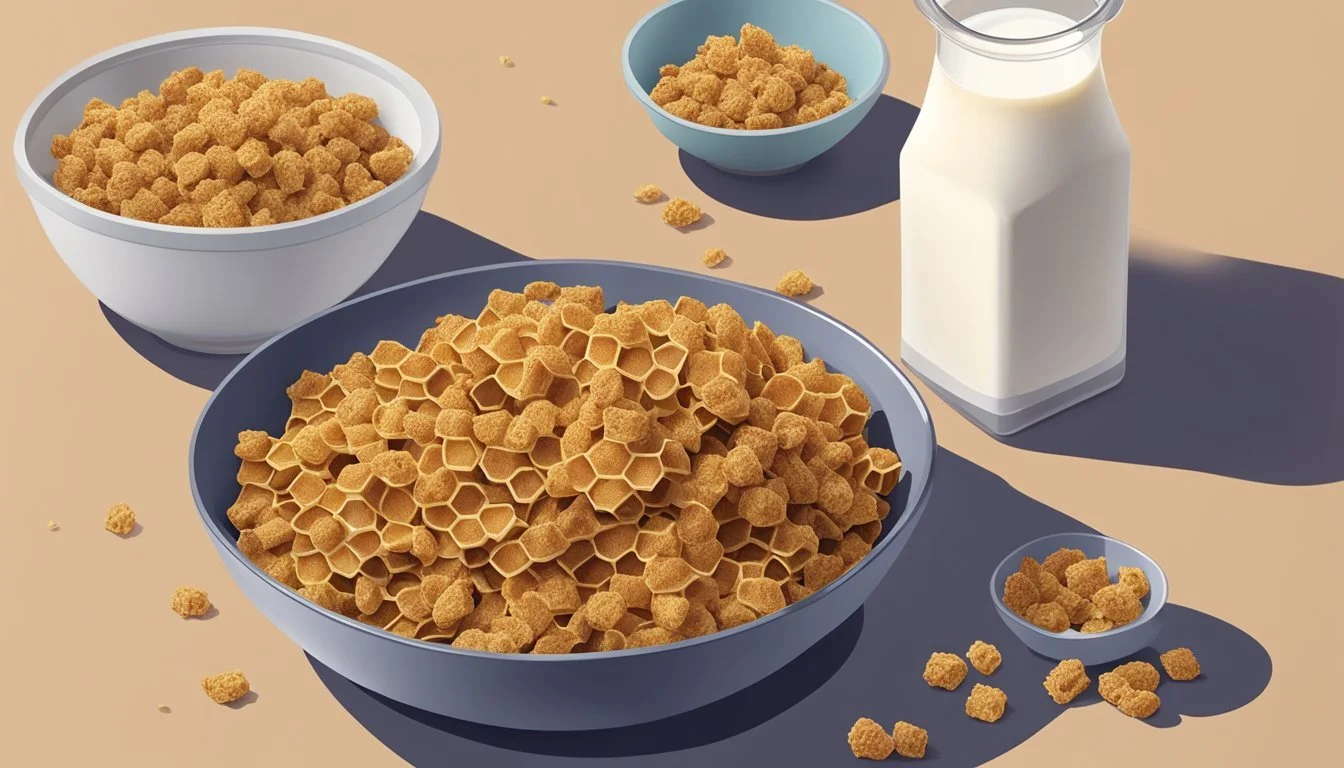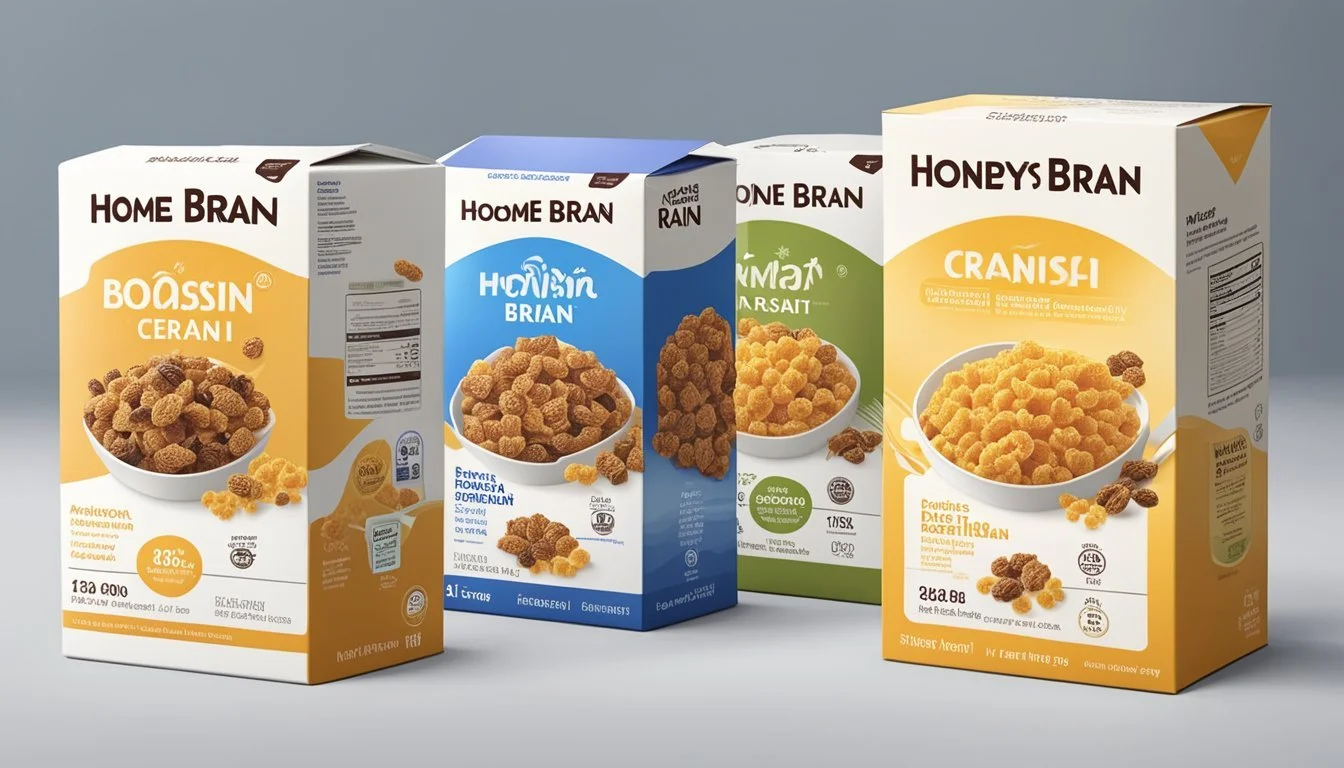Honeycomb vs Post Raisin Bran Cereal
A Nutritional Comparison
This Article is Part of Our Breakfast Cereal Guide with Details on Honeycomb Nutrition and Post Raisin Bran Cereal Nutrition
When it comes to choosing a cereal for breakfast, two popular choices often come to mind: Honeycomb and Post Raisin Bran. These cereals offer different nutritional benefits and flavors, catering to various preferences. For those looking for a higher fiber breakfast option, Post Raisin Bran stands out with its generous portion of raisins and bran flakes, making it a healthier choice in terms of fiber content.
On the other hand, Honeycomb cereal, known for its sweet taste and distinctive honeycomb shape, provides a fun and flavorful start to the day. While it may not pack as much fiber as Post Raisin Bran, it appeals to those who prefer a sweeter cereal with a crunchier texture.
Ultimately, your choice between Honeycomb and Post Raisin Bran will depend on your nutritional priorities and taste preferences. Whether you're aiming for a fiber-rich, more wholesome breakfast or a sweeter, crunchier option, this comparison aims to help you make an informed decision.
Overview of Honeycomb and Post Raisin Bran Cereals
Honeycomb and Post Raisin Bran are well-known breakfast cereals produced by Post Consumer Brands. Below is detailed information on their histories, brand details, product descriptions, and available variants.
History and Brand Information
Honeycomb cereal, introduced by Post Consumer Brands in 1965, is famous for its distinctive shape and sweet taste. The unique honeycomb shape is often highlighted in advertising campaigns. It has maintained its popularity across decades, especially among children.
Post Raisin Bran, also from Post Consumer Brands, was introduced in 1942. It is known for combining naturally sweet raisins with wholesome bran flakes. This combination offers a nutritious breakfast option rich in whole grains and fiber.
Both cereals have remained staples in many households, reflecting their longevity and brand strength.
Product Description and Variants
Honeycomb Cereal:
Flavor: Sweet with a hint of honey.
Shape: Large, hexagon-shaped cereal pieces.
Nutritional Info: Each serving provides vitamins and minerals, including a high amount of Vitamin B12 and Vitamin D.
Variants: Traditional Honeycomb remains the most popular, but limited editions and size variations occasionally appear.
Post Raisin Bran:
Flavor: Sweetness from raisins coupled with the nutty taste of bran flakes.
Shape: Flakes mixed with plump raisins.
Nutritional Info: High in fiber and essential nutrients. Each serving includes more dietary fiber compared to Honeycomb.
Variants: While the original version remains prevalent, there are variations such as Post Raisin Bran Crunch, which adds clusters for extra crunchiness.
Both products are packaged in colorful, branded boxes that capture the essence of their flavors and appeal to both children and adults.
Nutritional Comparison
When analyzing Honeycomb and Post Raisin Bran cereals, various factors such as macronutrient content, vitamin and mineral profiles, dietary fibers, sugars, and fat content should be considered. Each aspect plays a crucial role in determining the nutritional value and benefits of these cereals.
Macronutrient Content
Honeycomb Cereal and Post Raisin Bran differ significantly in their macronutrient composition.
Honeycomb Cereal:
Calories per Serving: Approximately 120 calories per serving.
Protein: Provides roughly 1 gram per serving.
Carbohydrates: Roughly 28 grams per serving, with a higher emphasis on sugars.
Fat: Contains about 0.5 grams per serving.
Post Raisin Bran:
Calories per Serving: Approximately 190 calories per serving.
Protein: Supplies about 5 grams per serving.
Carbohydrates: Around 46 grams per serving, with a significant portion being dietary fibers and added sugars.
Fat: Contains about 1.5 grams per serving.
Vitamin and Mineral Profiles
Vitamins and minerals vary between Honeycomb and Post Raisin Bran, affecting their nutritional value.
Honeycomb Cereal:
Vitamins: Rich in Vitamin B12 (90% daily need coverage) and Vitamin D (313 IU).
Minerals: Contains calcium and iron but at lower concentrations compared to Post Raisin Bran.
Post Raisin Bran:
Vitamins: Provides higher levels of Vitamin B6, Vitamin B1, and Folate.
Minerals: Significant in iron, with additional Copper (0.508 mg) and Magnesium.
Dietary Fibers and Sugars
The fiber and sugar content highlight one crucial difference between Honeycomb and Raisin Bran.
Honeycomb Cereal:
Dietary Fiber: Contains minimal dietary fiber, making it less favorable for those needing high fiber.
Sugars: Higher in sugars, contributing to its sweet taste but affecting blood sugar levels negatively.
Post Raisin Bran:
Dietary Fiber: Rich in dietary fiber, around 7 grams per serving, aiding in digestion and satiety.
Sugars: Includes natural sugars from raisins and added sugars, creating a balance of sweetness.
Comparison of Fat Content
Evaluating the fat content in both cereals can help understand their impact on a balanced diet.
Honeycomb Cereal:
Total Fat: About 0.5 grams per serving, with minimal saturated fats.
Cholesterol: Contains negligible amounts, making it heart-friendly.
Post Raisin Bran:
Total Fat: Around 1.5 grams per serving.
Types of Fat: Contains some monounsaturated and polyunsaturated fats, which are healthier.
Cholesterol: Low levels, contributing to overall cardiovascular health.
Assessing these cereals' nutritional components provides clarity on their health benefits and potential downsides for various dietary needs.
Health Considerations
When comparing Honeycomb and Post Raisin Bran cereals, it's essential to consider their compatibility with various diets and the recommended intake based on nutritional content. Both cereals offer unique benefits and drawbacks depending on individual health goals.
Diet Compatibility
Honeycomb cereal is low in fat, containing 0 grams per serving, making it a suitable choice for low-fat diets. It also has 180 milligrams of sodium per serving, which fits into diets with moderate sodium restrictions.
For those on a low-calorie diet, Honeycomb cereal might be preferable as it doesn't contribute significant fat content.
Post Raisin Bran contains 1 gram of fat per serving and offers a better profile in terms of protein, delivering 3 grams per serving compared to Honeycomb. This makes it a slightly better option for a high-protein, low-fat diet.
In terms of carbohydrates and glycemic index, both cereals should be consumed in moderation. Post Raisin Bran contains added sugars due to raisins and the cereal itself, potentially less suitable for low glycemic index diets.
Recommended Intake
The FDA recommendation for cereal serving size varies slightly based on brand specifications, but it typically ranges around 1 cup or 30 grams.
Here is a comparison of essential vitamins and minerals:
Honeycomb Cereal:
High in Vitamin B12.
Contains 313 IU of Vitamin D.
Post Raisin Bran:
Contains notable amounts of Copper (0.508 mg).
Provides Vitamin D, but significantly less than Honeycomb (102 IU).
Both cereals have different beneficial nutrients. For individuals needing high Vitamin B12 intake, Honeycomb would be more beneficial.
Notes about data: Always check the nutritional labels on packages as recipes and formulations may change, impacting these statistics. Serving weights, like ounces per serving, can differ, so it's important to measure accurately based on dietary needs.
Economic Aspects
When evaluating the economic aspects of Honeycomb and Post Raisin Bran cereals, critical factors include price differences and box sizes with their respective servings. Understanding these parameters helps determine which cereal offers better value for money.
Price Comparison
Honeycomb and Post Raisin Bran are both popular breakfast cereals, but their prices can vary significantly based on factors such as retailer and location. Honeycomb tends to be priced at approximately $3.50 per box, while Post Raisin Bran might cost around $4.00 per box.
Retail promotions and bulk purchasing options can also affect these prices. Consumers should consider frequent flyer miles, coupons, and store-specific discounts which can make a notable difference in cost.
Box Sizes and Servings
Box sizes and the number of servings per box directly influence the value for money of these cereals. A standard Honeycomb box typically contains 12 ounces, providing about 9 servings per box with a serving size of 1.33 cups.
On the other hand, Post Raisin Bran boxes usually weigh around 18 ounces and offer 13.5 servings per box, with a serving size of 0.67 cups.
By evaluating price per serving and considering packaging options like family-sized boxes, shoppers can make more informed purchasing decisions.
Consumer Experience
Consumers often consider various factors when choosing between Honeycomb and Post Raisin Bran. These factors include taste and texture, cereal ratings and reviews, and other aspects influencing purchase decisions.
Taste and Texture
Honeycomb features a light, airy texture with a sweet, honey-flavored taste, making it a popular choice among children. It remains crunchy in milk for a reasonable amount of time, providing a satisfying, crispy bite.
Post Raisin Bran combines crunchy bran flakes with chewy raisins, adding a mildly sweet and wholesome flavor profile. The textures of the bran flakes and raisins create a balanced experience, although the flakes can become soggy relatively quickly in milk.
Cereal Ratings and Reviews
Honeycomb: Consumers frequently praise its unique honey flavor and enjoyable crunch. Ratings on various review sites reflect its popularity with an average rating of 4 out of 5 stars.
Post Raisin Bran: Appreciated for its balance between nutritious bran and sweet raisins, Post Raisin Bran often receives commendations for providing a healthier breakfast option. Ratings show an average of 4.3 out of 5 stars, indicating a slightly higher preference among health-conscious consumers.
Other Factors Influencing Purchase Decisions
Nutritional Value: Post Raisin Bran, rich in fiber and essential vitamins, appeals to those seeking healthier breakfast options. Honeycomb, with fewer nutrients, primarily attracts consumers looking for a tasty, classic cereal.
Packaging: Both cereals come in visually appealing boxes, but Post Raisin Bran often highlights health benefits prominently, which can influence buyer decisions.
Brand Loyalty: Long-standing customers of Honeycomb or Post Raisin Bran tend to stick with their preferred brand due to trust and familiarity.
Price: Price sensitivity can also play a role, with consumers sometimes opting for the more affordable option during promotions or sales.
By examining these aspects, it becomes evident that the consumer experience with either cereal varies based on individual preferences and priorities.
Alternative Cereal Options
When comparing Honeycomb and Post Raisin Bran, it's helpful to explore other cereal options that might suit different nutritional needs and taste preferences. These alternatives include bran cereals that offer high fiber content and sweeter cereals for those looking for a more indulgent breakfast choice.
Comparable Bran Cereals
For those interested in cereals similar to Post Raisin Bran, Raisin Nut Bran by General Mills is a notable alternative. It combines raisins and nuts with bran flakes, providing a good source of fiber and essential nutrients. Another excellent choice is Kellogg's All-Bran, which delivers a high fiber punch necessary for digestive health.
Malt-O-Meal's Bran Flakes is a budget-friendly option with similar nutritional benefits. These cereals often contain added vitamins and minerals, making them a nutritious start to the day. Despite the differences in flavor, they maintain the primary benefits of bran cereals: high fiber and essential micronutrients.
Sweeter Cereal Choices
For those who prefer sweeter options like Honeycomb cereal, Malt-O-Meal's Marshmallow Mateys could be an enticing alternative. This cereal offers a fun and sweet taste with added marshmallows. Another option is General Mills' Lucky Charms, known for its colorful marshmallows and sugary flavor.
For a balance between sweetness and health, Honey Nut Cheerios from General Mills serves as a middle ground with lower sugar compared to some other sweet cereals but still enough to satisfy a sweet tooth. These choices cater to those seeking a more sugary, enjoyable breakfast while still providing some nutritional value.
Preparation and Serving Suggestions
Honeycomb Cereal and Post Raisin Bran are popular choices for a quick and nutritious breakfast. Including them in your morning routine is simple and convenient.
Basic Preparation
Pour into a Bowl
Start by measuring the recommended serving size. For Honeycomb, this is typically 1.33 cups. For Post Raisin Bran, a common serving size is 0.67 cups.Add Milk
Use your preferred type of milk, whether it's dairy or a plant-based alternative. About 1 cup of milk complements the cereals well, ensuring an enjoyable mix of crunch and creaminess.
Enhancing the Experience
Fresh Fruits:
Add sliced bananas, strawberries, or blueberries to boost fiber and vitamin content.
Nuts and Seeds:
Sprinkle almonds, walnuts, or chia seeds for additional protein and crunch.
Serving Suggestions
For a High-Energy Breakfast:
Combine Honeycomb with Greek yogurt and a drizzle of honey. This adds protein and natural sweetness.For a Fiber-Rich Start:
Mix Post Raisin Bran with a handful of mixed berries and a spoonful of flaxseeds. This provides a hearty start to the day.
Kid-Friendly Variation
For a fun twist kids will love, mix Honeycomb with mini chocolate chips and marshmallows. Serve with cold milk.
Quick Tips
Portion Control:
Use measuring cups to avoid over-serving and maintain nutritional balance.Custom Mix:
Combine both cereals in a bowl to enjoy the unique tastes and nutritional benefits of each.
Enjoying Honeycomb or Post Raisin Bran as suggested can make breakfast healthy, enjoyable, and full of variety.
Nutritional and Regulatory Information
Comparing Honeycomb and Post Raisin Bran cereals involves examining their nutritional values and the regulatory guidelines they must adhere to.
Labeling and FDA Guidelines
Both Honeycomb and Post Raisin Bran cereals must follow strict FDA guidelines for nutritional labeling. This ensures transparency about ingredients, calorie counts, and nutrients. Labels detail essential aspects such as serving size, total calories, and macronutrient breakdown (carbohydrates, proteins, and fats).
FDA recommendations for cereals include fortification with certain vitamins and minerals, like iron, folic acid, and various B vitamins. Labels must also indicate the amounts of dietary fiber, cholesterol, and sodium.
Honeycomb Cereal
Often highlights lower fiber content compared to bran cereals.
Lower in vitamins and minerals but may contain added sugars.
Post Raisin Bran
Higher in dietary fiber and essential vitamins and minerals, meeting daily requirements set by the FDA.
Health Implications
The nutritional profiles of Honeycomb and Post Raisin Bran have different health implications. Post Raisin Bran is rich in dietary fiber, aiding digestion, and promoting heart health by helping to lower cholesterol levels.
Honeycomb, while often enjoyed for its taste, typically has higher glycemic index due to added sugars, making it less suitable for those managing blood sugar levels. It also lacks the fiber content found in raisin bran, potentially leading to different satiety levels.
The sodium content in both cereals is something to consider. Excessive sodium intake is linked to higher blood pressure. Consumers need to be aware of these aspects when choosing between these cereals, especially if managing specific health conditions.
More on Honeycomb
More on Post Raisin Bran Cereal
Cinnamon Toast Crunch vs Post Raisin Bran Cereal: Which is better?
French Toast Crunch vs Post Raisin Bran Cereal: Which is better?
Honey Nut Cheerios vs Post Raisin Bran Cereal: Which is better?
Kellogg's Apple Jacks vs Post Raisin Bran Cereal: Which is better?
Kellogg's Froot Loops vs Post Raisin Bran Cereal: Which is better?
Post GrapevsNut Flakes vs Post Raisin Bran Cereal: Which is better?








